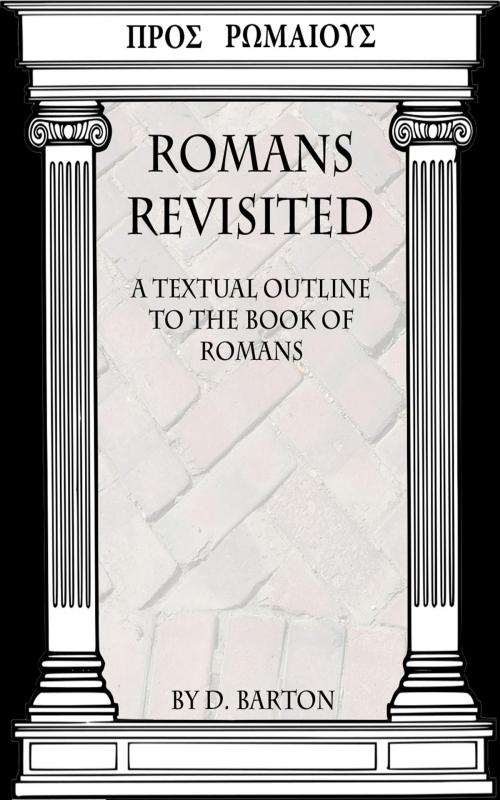| Author: | Darryl Barton | ISBN: | 9781311612649 |
| Publisher: | Darryl Barton | Publication: | May 25, 2015 |
| Imprint: | Smashwords Edition | Language: | English |
| Author: | Darryl Barton |
| ISBN: | 9781311612649 |
| Publisher: | Darryl Barton |
| Publication: | May 25, 2015 |
| Imprint: | Smashwords Edition |
| Language: | English |
Romans Revisited is not intended to be a commentary so much as it is a guide to understanding the general flow of thought in this very important epistle of Paul. Yet, very obviously, it does comment on the intended meaning of the text. Any outline of the book of Romans, apart from that one which might someday be offered by the Apostle Paul himself, or by the Spirit of God who led Paul in writing this part of God's Word, is by nature both subjective and artificial. Outlines are subjective because they depend upon an individual's own perception of what he feels the main ideas to be. They are artificial in that they try to fit the material of the text into a framework of these ideas.
Some Scriptures are very difficult to outline. Most of the epistles fall into this category simply because the writer himself probably had little or no outline in mind when he penned the letter. If you try to outline a personal letter written to you by someone, it will become evident that topics are discussed as they come to mind and often in little logical order.
Other Scriptures are somewhat easier because the writer did have an agenda to follow at least mentally. Such is the case with the book of Romans. While it is a personal letter, it was written to introduce the Apostle Paul and his gospel to those at Rome, a place he had never visited in his Christian ministry. It is to be expected then that Paul would carefully and logically present the message he proclaimed. And such he does.
In addition to this, there is another characteristic of the Epistle to the Romans which greatly aids one in outlining the book, but which has been often overlooked by many commentators. Paul used a very common teaching technique of that day and culture. He asked questions. One has only to casually study how Paul used questions to realize how important they are in understanding the flow of thought in this great treatise about our faith. Briefly stated, Paul asked a question, usually in anticipation of a question or objection that a listener or reader might ask. Then he very briefly answered the question, followed by a discussion of that question and answer. All too often outlines and discussions of the book of Romans are based upon one's theology rather than on the text itself. This is not to say the theology is wrong in many cases. Often the theology is accurate. The problem is simply that Paul did not follow our theology texts when he wrote this epistle. In our thinking today, the logical progression in our redemption is sin, salvation and then sanctification. Therefore, this is how many therefore see the development of Romans. They fit the text into this framework.
Paul however, if one follows the ideas as suggested by his questions and answers, is following a different progression of thought. There were issues in his day that are not nearly as important to us today. It is these issues he develops rather than following our theological progressions.
An overall outline of the book of Romans is given first followed by individual outlines of various sections. Note that the outlines are of a mixed sort. The overall outline contains both sentences and phrases. The section outlines are mostly made up of phrases. The overall outline contains the scripture references while the sectional outlines actually contain the scripture text itself. There are also two appendices that deal with two important translational issues.
Romans Revisited is not intended to be a commentary so much as it is a guide to understanding the general flow of thought in this very important epistle of Paul. Yet, very obviously, it does comment on the intended meaning of the text. Any outline of the book of Romans, apart from that one which might someday be offered by the Apostle Paul himself, or by the Spirit of God who led Paul in writing this part of God's Word, is by nature both subjective and artificial. Outlines are subjective because they depend upon an individual's own perception of what he feels the main ideas to be. They are artificial in that they try to fit the material of the text into a framework of these ideas.
Some Scriptures are very difficult to outline. Most of the epistles fall into this category simply because the writer himself probably had little or no outline in mind when he penned the letter. If you try to outline a personal letter written to you by someone, it will become evident that topics are discussed as they come to mind and often in little logical order.
Other Scriptures are somewhat easier because the writer did have an agenda to follow at least mentally. Such is the case with the book of Romans. While it is a personal letter, it was written to introduce the Apostle Paul and his gospel to those at Rome, a place he had never visited in his Christian ministry. It is to be expected then that Paul would carefully and logically present the message he proclaimed. And such he does.
In addition to this, there is another characteristic of the Epistle to the Romans which greatly aids one in outlining the book, but which has been often overlooked by many commentators. Paul used a very common teaching technique of that day and culture. He asked questions. One has only to casually study how Paul used questions to realize how important they are in understanding the flow of thought in this great treatise about our faith. Briefly stated, Paul asked a question, usually in anticipation of a question or objection that a listener or reader might ask. Then he very briefly answered the question, followed by a discussion of that question and answer. All too often outlines and discussions of the book of Romans are based upon one's theology rather than on the text itself. This is not to say the theology is wrong in many cases. Often the theology is accurate. The problem is simply that Paul did not follow our theology texts when he wrote this epistle. In our thinking today, the logical progression in our redemption is sin, salvation and then sanctification. Therefore, this is how many therefore see the development of Romans. They fit the text into this framework.
Paul however, if one follows the ideas as suggested by his questions and answers, is following a different progression of thought. There were issues in his day that are not nearly as important to us today. It is these issues he develops rather than following our theological progressions.
An overall outline of the book of Romans is given first followed by individual outlines of various sections. Note that the outlines are of a mixed sort. The overall outline contains both sentences and phrases. The section outlines are mostly made up of phrases. The overall outline contains the scripture references while the sectional outlines actually contain the scripture text itself. There are also two appendices that deal with two important translational issues.















